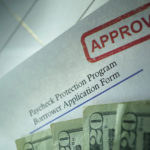By Adam Cmejla, CFP®

June 3, 2020
The last two months have been anything but normal for practices, and conversations with my OD-clients have similarly been anything but normal. Since the passage of the CARES Act, the Paycheck Protection Program (PPP) has dominated our conversations. Below are top areas of confusion–and the correct information to answer common questions.
Keep in mind that, as has been the common theme since the passage of CARES, the only thing that seems to be constant is change, so please know that what’s written below, especially around the forgiveness calculations, could be subject to change if either the Small Business Administration (SBA) and/or Treasury Department releases additional guidance.
Forgiveness Isn’t “All or None”
This may seem like an obvious statement, but it still comes up in so many conversations with ODs that I feel I must reiterate it here. In light of the recent passage of the PPP Flexibility Act of 2020, we know the basics about forgiveness: at least 60 percent of the amount forgiven must be used for payroll costs, however it doesn’t mean that forgiveness is an all-or-none situation. Take the following example:
• Practice receives $60,000 in PPP funding
• During the covered period (previously 8 weeks, now 24 weeks per PPP Flex Act) following your funding date), your practice has only generated payroll costs of $30,000).
• The total amount that could be forgiven is $50,000 ($30,000 in payroll costs divided by 0.6)
• Remaining $10,000 can be kept by the practice for future reserves or paid back to SBA with applicable interest
This has become a common challenge because there have been a number of practices that received funding during the first round of PPP funding but, due to stay-at-home orders, were not able to open their offices. Therefore, payroll was not being paid and PPP funds were sitting idle.
So, what can you do?
Bringing Your Spouse on Salary to Meet Forgiveness Options Hasn’t Been Ruled Out
This is admittedly a gray area, and one that should be met with honesty and integrity, but there hasn’t been anything documented that says that you cannot (a) hire anyone new into the practice and that this individual (b) cannot be a related family member.
Other Articles to Explore
If you can document that a family member is doing work for the practice (administrative tasks, calling patients, helping with billing, regularly managing and updating your web site and social media pages, drafting and sending out a series of e-mail messages to patients or doing other needed work on a regular basis), there’s nothing stopping you from putting them on payroll in the practice.
However, you will have to pass the meaningful wages test. Using my example above, it would be hard to justify putting your spouse on salary to “eat up” the remaining $10,000 for just sending out a couple of e-mails to clients or once in a while updating your practice’s Instagram account. Tread lightly with this one.
PPP Funds Are Not Tax Deductible
This is a big one that was communicated in IRS Notice 2020-32. Traditionally, all expenses that are paid from gross taxable income from a business are tax deductible to the business. However, the IRS has announced all that deducting expenses paid from PPP funds that are forgiven is essentially “double dipping.” Why is this important?
If you are on payroll, this is reducing the net effect of the grant to the practice owner. The goal of the program was to be a net-neutral effect: in the absence of this funding, practices wouldn’t have any income, and therefore, they couldn’t pay people. The government stepped in and gave you some free “dry powder” and essentially used your business as a conduit to funnel money to your employees, which will be taxed to them as ordinary income (and documented accordingly on their W2).
With most practices being pass-through entities (S-corps and partnerships), the practice deducts the owner’s salary as an expense to the practice and the practice owner pays the taxes at their personal tax rate.
With the recent IRS ruling, the expenses that are paid with PPP funds (including part of your salary, if you’re building that into the calculation) are not deductible AND the funds are taxed at your personal rate.
If, however, your practice continues to generate revenue during this downturn, there’s an inverse relationship between additional revenue generated and how much PPP will actually “cost” you as the owner of the practice.
Of course, this is assuming all other factors of the practice financials remain the same, which given COVID’s impact, are not the case. But most practices that I’m talking to are still generating some income (emergencies, contact-lens sales and telemedicine to name a few services being provided).
The only way this doesn’t have an impact on practice owners is if their practice was generating $0 revenue during the shutdown and they were simply paying their employees (including themselves). Any income generated during that period, while certainly not 100 percent of pre-COVID levels, is reducing the net effect of PPP to the practice owner.
What still remains unclear is how the IRS will want us to account for these funds on your practice’s tax documents (1120S for S-corporations and 1065’s for partnerships), your practice’s year-end payroll documents (W3) and whether there will be any separation of income on your team’s W-2s.
You Can Hire People
There’s ample documentation and explanation on how you can’t reduce your headcount and still have funds forgiven, but there’s been nothing written in the law that said you can’t ADD to your headcount. Therefore, given what I mentioned above about the lack of deductibility of expenses that are paid with PPP funds, it may actually be wise to consider keeping this ultra-cheap line of credit around for a future hire of an associate. As unfortunate as it sounds, this crisis is going to cost some practices their operations and there may be opportunities to scoop up a talented associate or gain market share.
When looking at business decisions, we must look at the cost of capital. This can either be in the direct cost of accessing capital (interest expenses, origination fees, etc) or the opportunity cost (what we otherwise could have done with that money had we not spent it in the practice). Given that the terms of the PPP are favorable (1 percent interest on a two-year loan), you may find situations where you need a short-term injection of capital to make a deal work for your practice.
For example, if an office ends up having $30,000 that can’t be forgiven, and decides to keep that money as a loan, (a) the payments are deferred for six months (though interest still accrues) and (b) the total tax-deductible interest expense to the practice on that $30,000 would be $592.91. If you decide at any given time that you don’t need the funds, there’s no prepayment penalty. Simply write the check back to SBA and pay off the loan in full.
Bottom line: don’t be so focused on getting 100 percent of it forgiven, because the longer-term play for you may be to keep additional cash on hand, especially since so much of the future is still unclear.
Editor’s Note: Not receiving 100 percent debt forgiveness comes with long-term consequences. Click HERE to download a loan forgiveness calculator, so you can see the level of debt you will be left with if you opt to not have all of the loan forgiven.
If you’re a 1099 independent contractor…
The SBA felt so bad for independent contractors that they came out with a completely separate Interim Final Rule for independent contractors. There’s a couple of points I want to emphasize related to ICs.
First, remember that you are both the employer and the employee. This means that the funding that you received as the employer is not considered income, and therefore, will be forgiven. However, as mentioned above, you as the employee will pay tax on the income. Until further guidance is received from the Treasury Department and SBA, plan on keeping additional money set aside for taxes.
Secondly, owner compensation (that’s you as a 1099/self-employed OD) received a boost from the recent passage of the PPP Flexibility Act, as your forgiveness amount was now increased to 24/52 of 2019 net profit.
You’ll still need to satisfy the 60 percent rule as mentioned above in order to have the loan forgiven, but you can still include utilities and other covered expenses in the calculation, so long as those expenses don’t exceed 40 percent of the forgiven amount.
Conclusion
To reiterate what I mentioned above, but in a slightly different way, the only thing that’s clear right now is that the future is unclear. I and the other professional advisors that I talk to are eagerly awaiting additional guidance on forgiveness calculations. The best advice that I can give right now is to make sure that you are keeping meticulous financial records, communicating with your advisors and making the best long-term decisions for your practice.
The last one is important. Remember, cash is king. Don’t let qualifying for forgiveness drive 100 percent of the decision-making process. Worst case scenario is that you have a very low-interest loan to use over the next 5-10 years at a hard-to-believe rate of 1 percent, should you need it. Best case scenario is that you don’t use it at all and pay it back in full with a nominal cost of capital (interest expense)—the price we pay for being business owners.
 Adam Cmejla, CFP® is a CERTIFIED FINANCIAL PLANNERTM Practitioner and Founder of Integrated Planning & Wealth Management, LLC, an independent financial planning & investment management firm focused on working with optometrists to help them reach their full potential and achieve clarity and confidence in all aspects of life. For a number of free resources, visit https://integratedpwm.com/ebooks/ and check out the “20/20 Money Podcast” on Apple Podcasts or your favorite podcast platform to get more tips on making educated and informed financial and business decisions.
Adam Cmejla, CFP® is a CERTIFIED FINANCIAL PLANNERTM Practitioner and Founder of Integrated Planning & Wealth Management, LLC, an independent financial planning & investment management firm focused on working with optometrists to help them reach their full potential and achieve clarity and confidence in all aspects of life. For a number of free resources, visit https://integratedpwm.com/ebooks/ and check out the “20/20 Money Podcast” on Apple Podcasts or your favorite podcast platform to get more tips on making educated and informed financial and business decisions.

























